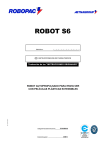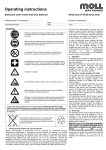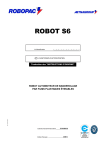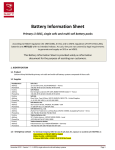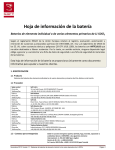Download Classic Solar EnerSol, EnerSol T, OPzS Solar Operating Instructions
Transcript
81700705 • • Classic Solar EnerSol, EnerSol T, OPzS Solar Operating Instructions for stationary lead acid batteries Nominal data • Nominal voltage UN • Nominal capacity CN = C100 or C120 • Nominal discharge current IN = I100 or I120 • Final discharge voltage Uf • Nominal temperature TN : : : : : Battery type: Number of cells/blocks: Assembly by: Exide Technologies order no.: 2.0 V x number of cells 120 h discharge (see type plate and technical data in these instructions) I100 = C100 / 100 h or I120 = C120 120 h see technical data in these instructions 25° C Commissioned by: date: Security signs attached by: date: Observe these Instructions and keep them located near the battery for future reference! Work on the battery should only be carried out by qualified personnel. • • Do not smoke! Do not use any naked flame or other sources of ignition. Risk of explosion and fire! • • While working on batteries wear protective goggles and clothing! Observe the accident prevention rules as well as EN 50272-2, EN 50110-1! • Any acid splashes on the skin or in the eyes must be rinsed with plenty of clean water immediately. Then seek medical assistance. Spillages on clothing should be rinsed out with water! • • Explosion and fire hazard, avoid short circuits. Avoid electrostatic charges and discharges/sparks! • Electolyte is strongly corrosive! • Blocks/cells are very heavy! Make sure they are installed securely! Only use suitable means of transport! Block/cell containers are sensitive to mechanical damage. Handle with care! • • • • Caution! Dangerous voltage. Metal parts of the battery are always alive, therefore do not place items or tools on the battery! Non-compliance with operating instructions and installations or repairs made with other than original accessories and spare parts or with accessories and spare parts not recommended by the battery manufacturer or repairs made without authorization and use of additives for the electrolytes (alleged enhancing agents) render the warranty void. Pb Spent batteries have to be collected and recycled separately from normal household wastes (EWC 160601). The handling of spent batteries is described in the EU Battery Directive (2006/66/EC) and their national transitions (UK: HS Regulation 1994 No. 232, Ireland: Statory Instrument No. 73/2000). Contact your supplier to agree upon the recollection and recycling of your spent batteries or contact a local and authorized Waste Management Company. 1. Start Up Check all cells/blocks for mechanical damage, correct polarity and firmly seated connectors. The following torques apply to the cell types: Ener Sol A-Pol 8 Nm ± 1 date: EnerSol T (M 10) 25 Nm ±1 OPzS Solar (M 8) 20 Nm ± 1 Put on the terminal covers if necessary. Check the electrolyte level in all cells and if necessary top up to maximum level with purified water acc. to DIN 43530 Part 4. Connect the battery with the correct polarity to the charger (pos. pole to pos. terminal). The charger must not be switched on during this process, and the load must not be connected. Switch on charger and start charging following acc. to 2.2. If there is only an alternative source of energy available, then the battery must be charged until the cell voltage is the same in all cells and the electrolyte density has reached the nominal value (see technical data). The loads must be switched off during charging. The insulation resistance measured at the disconnected loads and charger should be ≥ 100 Ω per volt nominal voltage. 2. Operation For the installation and operation of stationary batteries EN 50 272-2 is mandatory. The battery should always be operated using a charge controller and deep discharge protection. The battery must be installed so that it is not in direct sunlight and in a way which prevents ambiance-dependent temperature differences of > 3 K arising. The spacing between the cells or blocs should be 10 mm and at least 5 mm in rack mounting. 2.1 Discharge Discharge must not be continued below the voltage recommended for the discharge time. Deeper discharges must not be carried out. Discharge should not exceed the nominal capacity. Unless otherwise indicated by the manufacturer. Recharge immediately following complete or partial discharge. A battery is regarded as discharged when the electrolyte density is < 1.13 kg/l at 25° C. This corresponds to a discharge level of ca. 80% of the nominal value. An electrolyte density of < 1.13 kg/l is a deep discharge. Deep discharge reduces the lifetime of the battery. 2.2 Charging a) using an external charger All charging characteristics with their specific data, described in DIN 41773 (IU-characteristic; I-const.: ± 2%; U-const.: ± 1%) DIN 41774 (W-characteristic; ± 0.05 Vpc) DIN 41776 (I-characteristic; I-const.: ± 2%) may be used. Depending on to the charging equipment, specification and characteristics, alternating currents flow through the battery superimposing onto the direct current during charge operation. Alternating currents and the reaction from the loads may lead to an additional temperature increase of the battery, and strain the electrodes causing possible damage (see point 2.5), which can shorten the battery life. When charging with an external charger, the battery is disconnected from the load. The temperature must be monitored. Towards the end of the charging process the charge voltage of the battery is 2.6 V - 2.75 V times the number of cells. The charging process must be monitored (see points 2.4, 2.5 and 2.6)! On reaching a fully charged state, the charging process must be stopped or switched to the float charge voltage as in table 1. For charge current see point 2.6. b) with alternative power supply When using power supply units with solar modules or wind generators, the battery charger is not able to supply the maximum load current at all times. The load current intermittently exceeds the nominal current of the battery charger. During this period the battery supplies power. This results in the battery not being fully charged at all times. Therefore, depending on the load the charge voltage must be set at 2.23 V - 2.35 V x number of cells. This has to be carried out in accordance with the manufacturers instructions. Recommended charge voltage for cyclical application: Depending on the depth of discharge and the load the charge voltage is adjusted according to the specified values on table 1. Charging procedure IU-characteristic I-characteristic W-characteristic Range EnerSol EnerSol T OPzS Solar Charge voltage [Vpc] 2.32 - 2.40 2.30 - 2.40 2.28 - 2.40 Table 1: Recommended charge voltage for cyclical application The charge voltage has to be adjusted to reach the nominal value ± 0.01 kg/l (see technical data) once a month. If this is not the case, it is necessary to increase the recommended charge voltage stepwise by approximately 20 mVpc to a maximum of 2.40 Vpc according to table 1 or carry out an equalizing charge acc. to 2.4 every month. 2.3 Maintaining full charge (float charging) The devices used must comply with the stipulations under DIN 41773. They are to be set so that the average cell voltage is as in table 2 and the electrolyte density should not decrease over a lengthy period, if necessary the charge voltage Range EnerSol EnerSol T OPzS Solar Float charge voltage [Vpc] 2.27 2.25 2.23 Table 2: Float charge voltage must be increased acc. to table 1. 2.4 Equalizing charge Because it is possible to exceed the permitted load voltages, appropriate measures must be taken, e.g. switch off the load. Equalizing charges are required after deep discharges and/or inadequate charges. They can be carried out as follows: a) Using alternative form of power supply – at constant voltage of max. 2.4 Vpc up to 72 hours (the number of hours increases with less charging current acc.to table 3). b) Using an external charger – at constant voltage of max. 2.4 Vpc up to 72 hours – with I- or W-characteristic as in point 2.6. The electrolyte temperature must never exceed 55° C. If it does, stop charging or revert to float charge to allow the temperature to drop. The end of the equalizing charge is reached when the electrolyte density and the cell voltages no longer increase over a period of 2 hours (2 h-criterion only applies to I- and W-characteristics). 2.5 Alternating currents When recharging or boost charging up to 2.4 Vpc under operation modes 2.2 the value of the alternating current is occasionally permitted to reach 10 A per 100 Ah C10. In a fully charged state during float charge or standby parallel operation the value of the alternating current must not exceed 5 A per 100 Ah C10. 2.6 Charging currents When charging with the IU-characteristic, the charging current should be 10 A to 35 A / 100 Ah C10 (reference values). Exceeding this voltage of 2.4 Vpc increases water decomposition. Charging in cyclical application generates more heat. For that reason the charging currents shown in the following table 3 must not be exceeded. Max. charging current [A/100 Ah C10] 35 5 7 3.5 Charging voltage [Vpc] 2.40 2.60 - 2.75 at 2.40 at 2.65 Table 3: Maximal charging currents with different characteristics 2.7 Temperature The recommended operating temperature range for lead acid batteries is 10° C to 30° C. All technical data apply to the nominal temperature 25° C. The ideal operating temperature is 25° C ± 5 K. (OPzS Solar =20° C) Higher temperatures will seriously reduce service life. Lower temperatures reduce the available capacity. The absolute maximum temperature is 55° C. 2.8 Temperature-related charge voltage A temperature related adjustment of the charge voltage within the operating temperature of 10° C to 30° C is not necessary. If the operating temperature is constantly outside this range, the charge voltage has to be adjusted. The temperature correction factor is -0.004 Vpc per K. If the temperature is constantly in excess of 40° C, the factor is -0.003 Vpc per K. 2.9 Electrolyte The electrolyte is diluted sulphuric acid. The nominal electrolyte density ± 0.01 kg/l (acc. to technical data) is based on 25° C when fully charged and with the maximum electrolyte level. Higher temperatures reduce electrolyte density, lower temperatures increase electrolyte density. The appropriate correction factor is - 0.0007 kg/l per K. Example: electrolyte density of 1.23 kg/l at 40° C corresponds to a density of 1.24 kg/l at 25° C or an electrolyte density of 1.25 kg/l at 10° C corresponds to a density of 1.24 kg/l at 25° C. 3. Battery maintenance and control The electrolyte level must be checked regularly. If it drops to the lower electrolyte level mark, purified water must be added in accordance with DIN 43530 Part 4 (maximum conductivity 30 µS/cm). Keep the battery clean and dry to avoid leakage currents. Plastic parts of the battery, especially containers, must be cleaned with clean water without additives. Monthly measurements and recording: • Battery voltage • Voltage of some cells/block batteries • Electrolyte temperature of some cells • Battery-room temperature • Electrolyte density of some cells It is necessary to carry out an equalizing charge acc. to 2.4 if the cell/block average float charge voltages (see table 2) differ more than those in table 4 below and/or if the electrolyte density of the cells of a battery string deviates from the average-value more than ± 0.01 kg/l. Tolerance 2 V-Cell 6 V-Block 12 V-Block + 0.10 V 0.17 V 0.24 V – 0.05 V 0.09 V 0.12 V Table 4 Annual measurements and recording: • Voltage of all cells/block batteries • Electrolyte temperature of all cells • Electrolyte density of all cells Annual visual check: • Screw connections • Screw connections without locking devices have to be checked for tightness • Battery installation and arrangement • Ventilation the battery room 4. Tests Tests have to be carried out according to IEC 60896-11 and DIN 43539 Part1. Special instructions like VDE 0107 and EN 50172 have to be observed. 5. Faults Call the service agents immediately if faults in the battery or charging unit are found. Recorded data as described in point 3 simplify the troubleshooting and fault clearance. A service contract for example with Exide Technologies facilitates detecting faults in time. 6. Storage and taking out of operation To store or decommission cells/blocs for a longer period of time, they should be fully charged and stored in a dry and cold but frost-free room, away from direct sunlight. To avoid damage, the following charging methods can be chosen: 1. Equalizing charges every three months as described under point 2.4. At average ambient temperatures of more than the nominal temperature shorter intervals can be necessary. 2. Float charging as under point 2.3. 7. Transport To prevent any leakage of electrolyte, the cells/ block batteries must be transported in an upright position. Cells/block batteries without any visible damage are not defined as hazardous goods under the regulations for transport of hazardous goods by road (ADR) or by rail (RID). They must be protected against short circuits, slipping, upsetting or damaging. Bloc batteries may be suitably stacked and secured on pallets (ADR and RID, special provision 598). It is prohibited to stack pallets. No dangerous traces of acid may be found on the exteriors of the packing units. Cells/bloc batteries whose cases leak or are damaged must be packed and transported as class 8 hazardous goods under UN no. 2794. 8. Technical data The nominal voltage, the number of cells, the nominal capacity (C100 or C120 = CN) and the battery type are described on the type plates. See table 8.1.1 - 8.1.3 other capacities at different discharge currents with the corresponding discharge times. 8.1 Measurements, weights and capacities (Cn) at different discharge times (tn) and final discharge voltage (Uf) 8.1.1 Stationary lead acid bloc batteries type EnerSol with positive and negative grid plates, Nominal electrolyte density 1.28 kg/l Discharge data Capacity [Ah] Discharge time [h] Final discharge voltage [Vpc] EnerSol 50 EnerSol 65 EnerSol 80 EnerSol 100 EnerSol 130 EnerSol 175 EnerSol 250 1) Discharge current [A] 120 100 120 100 1.85 1.85 1.85 1.85 53 66 80 99 132 179 256 52 65 78 97 130 175 250 0.44 0.55 0.67 0.83 1.10 1.49 2.13 0.52 0.65 0.78 0.97 1.30 1.75 2.50 Length max. [mm] 210 242 278 353 349 513 518 Measurements and weights Width Height 1) Weight max. max. including acid approx. [mm] [mm] [kg] 175 190 13.7 175 190 17.3 175 190 20.7 175 190 26.4 175 290 33.0 223 223 47.8 276 242 63.0 Weight acid approx [kg] 2.1 2.7 4.7 7.0 10.9 14.6 18.6 The above mentioned height can differ depending on the used vents 8.1.2 Stationary lead acid cells type EnerSol T with positive and negative grid plates, Nominal electrolyte density 1.26 kg/l Discharge data Capacity [Ah] Discharge time [h] Final discharge voltage [V] EnerSol T 370 EnerSol T 460 EnerSol T 550 EnerSol T 650 EnerSol T 760 EnerSol T 880 EnerSol T 1000 EnerSol T 1130 EnerSol T 1250 1) Discharge current [A] 120 48 24 10 120 48 24 10 1.85 1.80 1.80 1.80 1.85 1.80 1.80 1.80 367 452 542 668 779 897 1025 1154 1282 361 437 524 656 766 854 1008 1134 1260 333 416 499 625 729 840 960 1080 1200 280 350 425 527 615 714 809 910 1011 3.06 3.77 4.52 5.57 6.49 7.48 8.54 9.62 10.68 7.52 9.10 10.92 13.67 15.96 17.79 21.00 23.63 26.25 13.88 17.33 20.79 26.04 30.38 35.00 40.00 45.00 50.00 28.0 35.0 42.5 52.7 61.5 71.4 80.9 91.0 101.1 The above mentioned height can differ depending on the used vents Length max. [mm] 83 101 119 119 137 137 155 173 191 Measurements and Weights Width Height 1) Weight Weight max. max. including acid acid approx. approx. [mm] [mm] [kg] [kg] 198.5 445 17.3 5.1 198.5 445 21.0 6.3 198.5 445 24.7 7.5 198.5 508 29.5 8.6 198.5 508 31.0 10.0 198.5 556 38.0 11.0 198.5 556 43.1 12.6 198.5 556 47.7 14.1 198.5 556 52.8 15.6 8.1.3 Stationary lead acid bloc batteries type OPzS Solar bloc batteries and single cells with positive tubular plates and negative grid plates, Nominal electrolyte density 1.24 kg/l Bloc battery Discharge data Capacity [Ah] 12V 12V 12V 6V 6V 6V Discharge time [h] Final discharge voltage [V] OPzS Solar OPzS Solar OPzS Solar OPzS Solar OPzS Solar OPzS Solar Discharge current [A] Length max. 120 48 24 10 120 48 24 10 1.85 1.80 1.80 1.80 1.85 1.80 1.80 1.80 70 140 210 280 350 420 82.7 139.0 210.0 294.0 364.0 417.0 78.4 141.0 200.0 296.0 374.0 420.0 69.4 118.0 177.0 250.0 311.0 354.0 51.5 103.0 154.0 206.0 257.0 309.0 0.7 1.2 1.8 2.5 3.0 3.5 1.6 2.9 4.2 6.2 7.8 8.8 2.9 4.9 7.0 10.5 13.0 14.8 5.2 10.3 15.5 20.6 25.8 30.9 [mm] 275 275 383 275 383 383 190 245 305 380 450 550 660 765 985 1080 1320 1410 1650 1990 2350 2500 3100 3350 3850 4100 4600 190 245 305 380 450 550 660 765 985 1080 1320 1410 1650 1990 2350 2500 3100 3350 3850 4100 4600 165 215 270 330 395 480 575 670 860 940 1150 1225 1440 1730 2090 2215 2755 2985 3430 3650 4100 145.0 190.0 240.0 300.0 355.0 430.0 515.0 600.0 770 845 1030 1105 1290 1550 1910 2015 2520 2740 3135 3355 3765 132.0 173.0 220.0 273.0 325.0 391 469 546 700 773 937 1009 1174 1411 1751 1854 2318 2524 2884 3090 3451 1.6 2.0 2.5 3.2 3.8 4.6 5.5 6.4 8.2 9.0 11.0 11.8 13.8 16.6 19.6 20.8 25.8 27.9 32.1 34.2 38.3 3.4 4.5 5.6 6.9 8.2 10.0 12.0 14.0 17.9 19.6 24.0 25.5 30.0 36.0 43.5 46.1 57.4 62.2 71.5 76.0 85.4 6.0 7.9 10.0 12.5 14.8 17.9 21.5 25.0 32.1 35.2 42.9 46.0 53.8 64.6 79.6 84.0 105.0 114.2 130.6 139.8 156.9 13.2 17.3 22.0 27.3 32.5 39.1 46.9 54.6 70.0 77.3 93.7 100.9 117.4 141.1 175.1 185.4 231.8 252.4 288.4 309.0 345.1 105 105 105 126 147 126 147 168 147 147 215 215 215 215 215 215 215 215 215 215 215 Measurements and Weights Width Height 1) Weight Weight max. max. including acid acid approx. approx. [mm] [mm] [kg] [kg] 208 385 35 15 208 385 45 14 208 385 64 19 208 385 41 13 208 385 56 20 208 385 63 20 1) The above mentioned height can differ depending on the used vents Exide Technologies GmbH Im Thiergarten 63654 Büdingen – Germany Tel.: +49 (0) 60 42 / 81 544 Fax: +49 (0) 60 42 / 81 398 www.industrialenergy.exide.com 208 208 208 208 208 208 208 208 208 208 193 193 235 277 277 277 400 400 490 490 580 405 405 405 405 405 520 520 520 695 695 695 695 695 695 845 845 815 815 815 815 815 13.7 15.2 16.6 20.0 23.3 26.7 31.0 35.4 43.9 47.2 59.9 63.4 73.2 86.4 108.0 114.0 151.0 158.0 184.0 191.0 217.0 5.2 5.0 4.6 5.8 6.9 8.1 9.3 10.8 13.0 12.8 17.1 16.8 21.7 26.1 33.7 32.7 50.0 48.0 60.0 58.0 71.0 81700705 0,5 III.09 OPzS Solar OPzS Solar OPzS Solar OPzS Solar OPzS Solar OPzS Solar OPzS Solar OPzS Solar OPzS Solar OPzS Solar OPzS Solar OPzS Solar OPzS Solar OPzS Solar OPzS Solar OPzS Solar OPzS Solar OPzS Solar OPzS Solar OPzS Solar OPzS Solar NXCSLOEPDF00710 · Druckhaus Bechstein · Printed in Germany · Subject to change without prior notice Single cell





